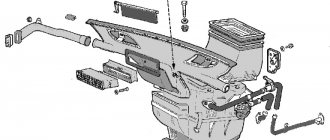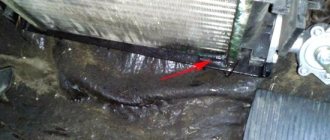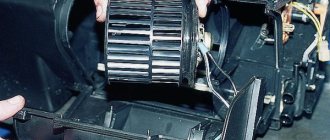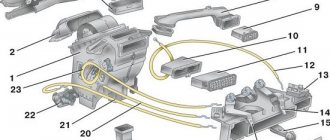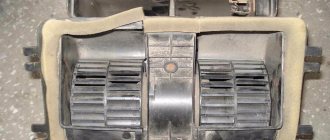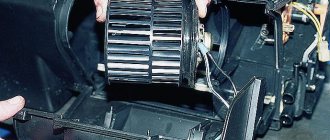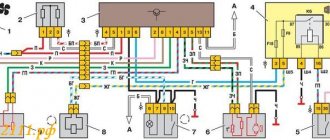Checking components
Naturally, disassembling the stove on a VAZ 2110 and checking its components is necessary if you are dissatisfied with its operation, and also if it cannot be adjusted.
So:
The first thing to do is check to see if the fuse has blown. And although, if this happens, the thought immediately arises - change the blown fuse, do not rush. This is unlikely to immediately solve the problem; most likely, it is not the cause, but a consequence of some kind of failure that needs to be found; First of all, you need to check whether the damper moves when the parameters of the heater sensor change
Carefully, so as not to break the wire going to the backlight, remove the deflectors. Now you can clearly see whether the damper is turning or not
If you need to replace the heater damper, then installing an aluminum one instead of a plastic one will be justified; Check the resistance of the temperature sensor. If the temperature in the cabin is 16°C, then its resistance should be 250 Ohms, at 22°C - about 200 Ohms. If this is not the case, then installing a new sensor should help; It is also advisable to check the controller: remove it from the socket, turn on the ignition and, using the handle to change the temperature parameters, measure the voltage on the long connector. If the voltage does not change, then it is faulty; To check the gear motor of the stove, you will have to do a little disassembly: remove the frill, get to the drive of the gear motor (brown and pink wires are connected to it). Apply current from the battery to the connector. If it spins, it means it’s working, if not, you may need to install a new one; If the heater only operates in one position, the additional resistance (resistor) through which the fan is connected may have burned out. Installation of a new one is possible only from the engine compartment; Check if the wires in the controller are burnt out. To do this, it needs to be disassembled; On the right under the hood you will find the relay box. It is very possible that a wire has come loose from the relay responsible for operating the heater. At the same time, check the relay that turns on the heated rear window. If you do not have such heating, when tuning the stove, you can include this relay in the system; If the air entering the VAZ 2110 interior does not warm up sufficiently, be sure to check the antifreeze level, as well as the absence of its leakage from the heater;
20.2.8. Heating and ventilation system for cars with VAZ-21114 and VAZ-21124 engines
On cars of the “tenth” family with VAZ-21114 and VAZ-21124 engines, a new type of heater housing is installed with different attachment points to the body and a modified location of the fan electric motor. A different circuit for supplying fluid to the heater radiator was also used.
In the circuit for switching on the electric motor of the heater fan, an additional resistor of a new type is used, equipped with a built-in fuse.
...can be either three- or four-pin (four-pin assembly shown) - for three- and four-way switches, respectively
To diagnose the heating and ventilation system, its controller is connected to the diagnostic block of the engine control system.
Now you can check the operation of the heating and ventilation system using a diagnostic tool.
Central ventilation nozzles with horizontal movement of the air flow adjustment handle can be installed in the car interior.
The vehicle may be equipped with a cabin air recirculation system. If a recirculation system is not installed, the car is equipped with a filter for cleaning the air entering the interior ventilation and heating system.
Replacing the air purification filter entering the interior ventilation and heating system
- Without disconnecting the washer hose, remove the wind window trim (see Removing the wind window trim and trim) and move it to the side (for clarity, the car hood has been removed).
- Using a Phillips screwdriver, unscrew the four screws...
- Drain the coolant (see Replacing the coolant).
- We remove the wind window trim (see Removing the wind window trim and trim), the right side of the soundproofing trim (see Removing the wind window trim and trim) and the throttle assembly (see Removing the throttle assembly).
- We loosen the fastening of the inlet pipeline: we unscrew the cap nuts of the upper fastening completely, and we do not unscrew the two bolts and three nuts of the lower fastening completely.
- We loosen the tightening of the self-tapping screw securing the guide tube of the oil level indicator and lift the tube so that its fastening bracket disengages from the self-tapping screw.
- Remove the ignition coil of the first cylinder.
- We disconnect (can be cut) the clamp securing the block of the heater motor power wires and the additional resistor wires.
- Disconnect the heater motor power supply wire block.
- Disconnect the wire block from the additional resistor connector.
- Use a Phillips screwdriver to loosen the clamp...
...and disconnect the supply hose from the upper pipe of the heater radiator.
- Use the same tool to loosen the clamp...
...and disconnect the outlet hose from the lower pipe (it has a smaller diameter than the inlet).
We do not disconnect the steam exhaust hose from the heater radiator, since its fastening clamp is difficult to access. It is easier to disconnect this hose from the expansion tank branch pipe (see Removing the expansion tank) and remove the heater housing along with the hose.
- We remove the steam removal hose from the clamp on the windshield wiper rod.
- Disconnect the power supply block from the micromotor-gearbox of the damper drive.
- Disconnect the wiring harness from the throttle position sensor.
- Using a 10mm socket with an extension, unscrew the nut of the upper fastening of the heater housing to the body on the right side of the engine compartment.
- Using a socket or an 8-point wrench, unscrew the self-tapping screw of the upper fastening of the heater housing, located next to the fastening of the windshield wiper drive rod.
- Unscrew the nut of the upper fastening of the heat shield of the steering rack cover.
Causes of poor-quality foot airflow
Almost all vehicle owners face the problem when the heater in the driver’s feet does not work on a VAZ-2110. The heating system on domestic cars has significant disadvantages - this is a weak air flow into the driver’s feet and towards the side windows. Often this situation occurs even during normal operation of the heater.
There may be several reasons for this, and all of them are related to the technical features of the heating system design.
The first and main reason why the stove does not heat with the required intensity is poor-quality sealing of the heating system air ducts. The heater ducts are made of plastic and have a large number of slots around the perimeter. As a result, a significant amount of warm air is lost through the holes in the air ducts and a weak flow reaches the final destination.
The second element of the heating system, which requires improvement for better heating of the interior, is the plastic air distribution unit. People also call the driver his Christmas tree. This unit also has slots, which significantly reduces the flow of warm air to the driver's feet, side windows and to the rear seats of the vehicle.
The next detail that causes poor heating of the interior is. Due to its design features, it does not fit tightly to the panel body. As a result, most of the hot air remains in the engine compartment and in the dashboard.
As you can see, the complex reason that the stove is blowing weakly is poor-quality sealing of the VAZ-2110 heater elements and the presence of a large number of cracks in the car’s heating system.
Before you begin to eliminate factory defects in the heater, you need to make sure that it is working properly
In case of problems with the functioning of the stove, it is important to first repair worn-out or damaged parts, and only then upgrade the heating system. Only in this case, modifications to the heating system of the vehicle will give a tangible positive result.
Device
First of all, you should know the very structure of the heating system in order to clearly understand what and how to repair, because for the VAZ 2110, interruptions in the operation of the heater are a typical phenomenon, and from time to time requiring the intervention of reliable hands - be it a driver or a service station worker.
For stable and high-quality driving in a car, it is recommended not only to be able to use the heating system, but also to understand the heater’s structure. The operating principle of the system can be found here:
So, the heating system consists of: 1. The actual heater unit, which provides heating for the interior. It is represented (by importance of details):
- An electric motor on which a fan is also attached to pump hot air;
- A radiator, without which the entire system does not work. Moreover, unlike the old heater, the radiator of the VAZ 2110 stove of the new model does not have a tap that shuts off the flow of antifreeze (antifreeze) through the radiator. Thus, it is always (whether in winter or in summer) heated. This was done supposedly in order to eliminate leaks that were often observed through this tap, and also to heat the interior as quickly as possible when necessary. In the summer, the supply ventilation goes past the radiator, but still some VAZ 2110 owners, when repairing the stove, add this tap to the system;
- There are three dampers. One is responsible for air intake recirculation, the second opens/closes the heater duct, the third, the most important for the interior, controls the heater;
- A resistor that regulates the blowing speed.
Heater parts VAZ 2110
All parts are packaged in a block with additional valves, shields, and fittings. This entire device is housed in a housing and is located under the hood closer to the instrument panel.
2. The next block represents the air ducts of the VAZ 2110. They extend directly from the stove and provide:
- Interior ventilation through central nozzles;
- The air distributor works to supply heat (or regular air for ventilation);
- Two air ducts are directed to the rear of the cabin;
- There is a whole system of five nozzles for heating the feet;
- Two side air ducts provide heating for the side windows and part of the interior, providing better heating;
- Two nozzles for ventilation.
Operating principle of the heater
This, in a nutshell, is the principle of distribution of hot or cold air inside the VAZ 2110.
3. The electronic control unit for the stove operates from the passenger compartment. It includes:
- Controller handle. This device allows you to set the temperature in the cabin that the stove unit should produce. It turns on by turning the knob and sets the temperature from the air, the temperature of which will correspond to that outside, up to 30°C. Most often, this part is called the ACS controller (automatic heater control system);
- The temperature sensor is responsible for turning on the heater when the temperature in the cabin drops by 2 degrees against the set one. The sensor has a microfan, and if the control knob is in position A, then the micromotor in the stove block turns on and the damper begins to operate, ensuring proper heating. Therefore, before starting repairs of the heating system, the operation of this sensor is usually checked. It is located next to the heating lamp on the ceiling of the VAZ 2110. Since it is not repairable, in the event of a breakdown this device should be replaced immediately.
This material will help you quickly and efficiently replace the heater fan in a VAZ 2110:
Ceiling interior air temperature sensor
Advice from experienced car owners
Eugene:
“I never thought I would encounter such a problem, but it happened. After repairing the cylinder head, it became very difficult to warm up the interior. I spent a long time searching for why, and it turned out that the engine was throttling. I did everything as advised, the coolant stopped bubbling only after 4 hours, but now it’s always warm in the cabin.”
Sanya:
“I have a VAZ 2109i, it blew cold at idle. I added coolant to the expansion tank, everything was ok.”
Rustam:
“I drive a 6th Mazda. Last winter, the heater began to act like a fool: over 2 tons of revolutions, hot air came out of it, over 3 tons, despite how much the temperature was set, the heater practically boiled with boiling water, but as soon as you stopped, the air became cool. I went through all the possible options described in the article, the problem did not go away, after a long search, the service station technicians found the reason - the climate control system had failed.”
We recommend: What to do if the wipers on a VAZ-2110 do not work: possible reasons
Ruslan:
“On my Priora, the stove also blew cold at idle, so to fix this I had to constantly add antifreeze. Got tired of it, sealed the lower pipe, now everything works properly.”
Oleg:
“As a service station worker, I can say that the warmest stove among all domestic cars is in Kalina, but sometimes it also malfunctions
As a rule, the whole problem lies either in the gasket of the pump, or in the pump itself, so if you are the owner of the named car, in which case the first thing you should pay attention to is the pump and its components.”
“Human” hood or ventilation with valves
Interior ventilation. I wonder if anyone has ever wondered how it is made in modern Samara? Not at all like the entire global auto industry has been doing for the last quarter of a century. And not even at all in the same way as it was done on the Samaras produced in the 1990s. This can cause all the problems - fogging, stuffiness, cold in winter, dirt in the doors, dust in the cabin, weak air flow from the deflectors.
And at one point I got tired of it all. In particular, the biggest inconvenience was the fogging of windows in wet weather, especially when there are two or more people in the car. Combined with the “high” panel, this is a disaster. When it rained, everything got much worse. Moreover, there was no cabin filter.
The car was also soundproofed and sealed in the doors, but it only froze my feet in the winter and caused dirt to spread in the doors. After this, I began to notice that my ears began to become blocked, the air was not coming out anywhere at all, that is, the pressure in the cabin was being created quite strongly. I thought the problem was blocked ventilation, but I remembered that as soon as I bought the car, the problem already existed, and the windows sweated quite a lot.
In this regard, it was decided to take this issue seriously. It was necessary to put valves in the trunk, as on all modern cars, and an adapter for the 2110 filter, a very useful thing, simply necessary for Samara. There should still be a cabin filter - less dirt will get in, and with the adapter the ventilation system will be sealed, and in total - no leaves and dust in the air ducts.
For the upcoming work, I collected information, went to forums, looked for pictures, diagrams, photographs, and looked at how it was done on different machines. I found a lot of useful things and realized that I could implement this in my car, I went to the car market and bought valves from Kalina, but they were smaller than those of the “twelve”. But then, in 2009, it was quite difficult to find valves for the “two-wheeler,” because in the 2110 family, cars began to be equipped with them only after 2006, and today they are sold almost everywhere. (And looking ahead, I’ll say that you can pick up similar valves even from a foreign car.)
So, the only thing left to do is to deliver it.
The summer season has arrived, I came to the dacha. May 1 - everyone goes to the demonstration, and I go to the garage. Using the Murzilka, removing the bumper is just two steps, about 10 minutes. As it turned out, it had to be removed with the brackets; the bolts could not be unscrewed; I spent a good hour and a half on all this work. When I finally removed the trunk, I began to try on where to put the whole thing.
I thought it might not fit under the headlights, or closer to the center, but on a flat panel under the number, which is much easier. In the end, as a true “vasoman”, I was pushed away from the simple path, and I decided to put it under the headlights.
I removed the plastic, there was not much dirt there after seven years, just dust. I made a pattern from a piece of splen. I decided to modify the valve by sawing off the top edge, since according to calculations it should go flush with the bumper. Having attached the pattern, I made markings on the body. Everything is by eye, without any special measurements, no certainty.
I sawed through the space for the valve. This was my first communication with the “Bulgarian’s wife,” so I didn’t have to count on the “evenness” of the cut. I sawed off the edge of the valve from below so that it would not touch the bracket for attaching the bumper, and then, at the bottom of the cut, I went over it with a hammer, bent the metal and inserted the valve.
And the time has come to check your work. I turn on the fan, and there it is, a stream of air! It turns out, as expected, the system works. If you close one valve with your hand, the rubber bands on the second open much more.
The bumper fits into place normally and does not hit anything. I was even surprised that everything went without difficulties. The amplifier is of course close, but nothing interferes with the operation of the valve. Now you put your hand under the bumper, and air flows from there.
Then, out of curiosity, he reclined the seat and sat in the cabin. I turn on the fan, the valves open, the second speed is higher, the third is even higher. In order for them to close when the fan is on, you need to open the window more than three centimeters, and when you slam the door, they open very strongly. It feels like in practice the interior has become much better ventilated.
One day it was quite hot, I was driving along the Moscow Ring Road with the windows closed, the fan turned on at second speed. Quite comfortable at speeds of 80–120 km/h. Previously, this would have been a complete gas chamber. Thanks to the adapter with its filters, the fan can be turned off at 100 kilometers per hour, and then the air flow enters the cabin by gravity. Exhaust gases do not enter the cabin, either with the windows closed or open. The glass quickly becomes dry, in winter the interior warms up perfectly, the wind does not blow heat through the doors, and they are now clean. Which I am certainly happy about.
Sergey Turlyansky, Moscow
Operating modes
You can configure the heater operation manually or automatically. That is, you can set the temperature sensor according to your wishes, for example, at 22°C. If everything is in order, then the manufacturers promise that the deviations will be no more than 2°C, after which the relay will turn on the heating again, and after reaching the specified parameters, turn it off. But if failures occur, then after checking the functionality, it is quite possible that the sensor or relay will need to be replaced.
You can set the automatic mode. For this there is a special screw, the so-called tuning screw. It is advisable to make adjustments with the windows and doors closed. The fan handle should be in position “A”, and set the temperature at your discretion.
Take a test thermometer to the salon. If after 15 minutes the temperature does not correspond to the specified parameters, then you need to remove the controller from the socket and turn its adjustment screw. Clockwise to increase the temperature, counterclockwise to decrease it. If this does not help, then the sensor needs to be replaced.
SAUO block without panel
In addition, you may need to install a new control unit, or even tuning the entire heating system.
Problem solving
Now let's talk about how to troubleshoot problems that arise, troubleshoot problems, and return the heater to normal operation.
Each breakdown requires separate consideration.
Temperature not regulated
If it is not possible to regulate the temperature of the air flow, the problem lies in the control unit or damper, or the temperature sensor on the ceiling inside the cabin does not work.
To check, turn the control all the way to the right and place your hand under the air stream. If hot air only flows when the control is in the maximum heating position, replace the sensor. If this does not help, replace the regulator. When heat is transferred to other places on the controller, the sensor should not be at fault.
Be sure to check that the shock is not blocked. You can get to it through the engine compartment. If replacement is required, replace the standard plastic curtain with an aluminum one. It's more durable.
Blowing cold
If the heater on your VAZ 2110 starts blowing cold air, then you need to look for the reasons. The reason for the failure lies in the gear motor. A similar situation occurs in 9 out of 10 cases, so it is unlikely that you will have to look for alternative culprits.
The gear motor must be replaced. This is done as follows:
- The fringe and windshield wipers are back in place. Job is done.
- Wipers removed;
- Unscrew the three screws holding the gear motor;
- The ruffle is dismantled;
- Disconnect the wiring;
- A new one is installed in place of the failed device. Ask an assistant to change the position modes of the regulator and at this time you will install the gear motor;
But there is 1 case out of 10 that will force you to change the heater due to wear and tear of the old one. As the practice of VAZ 2110 owners shows, the heater from 2112 is more suitable for replacement. In addition, you can choose between two stove options: 2112-01 or 2112-02. The first option is without an air filter, and the second option is without it.
The windows fog up, the feet are not heated
VAZ models often have a problem when the air comes out of the stove normally, but does not warm the feet and does not go into the glass.
The problem can be solved by updating the air ducts and eliminating existing cracks in the cabin and hot air ducts. This is a rather complicated procedure, the implementation of which will allow you to forget for a long time about the problem with the stove, which does not heat the legs and does not blow up the side windows.
It would not be superfluous to mount a pre-heater. Due to this, the interior heats up faster.
Causes of poor foot airflow
Heater malfunction
Air through the cabin filter is taken from the street by the rotating blades of the electric heater motor. Through a damper system, air is distributed through air ducts and supplied into the cabin through deflectors and non-adjustable grilles.
Air, like any gaseous medium, tends to follow the path of least resistance. Therefore, it is logical that the air flows first come out of the central and side deflectors. The feet of the driver and passengers are blown last. Structurally, the air ducts to the central deflector and the upper side airflow points have a larger cross-section, and it is much easier for air to pass through them.
Initially, you need to make sure that nothing interferes with the intake of air from the atmosphere. After all, if the air is supplied in insufficient volume, then it will not be enough to supply all airflow points with the intensity that was calculated at the design stage of the car.
Check the condition of the cabin filter. To do this, remove the wipers and frill. The cabin filter is located on the right side of the vehicle under the windshield. It is covered with a plastic casing, which is secured with four self-tapping screws. Unscrew the screws and remove the cabin filter. We start the engine, warm it up to operating temperature and check the operation of the stove. If the situation has improved, change the cabin filter and close the issue.
The second common cause is a clogged heater core. In this case, the heating of the interior will be weak, because warm air does not come out of all the deflectors well, and not just into the legs. But the fact is that when driving for a long time, your feet begin to freeze first, so it seems that the problem is in this part of the airflow.
Video: Why the stove does not blow at the feet of VAZ 2111,2110
This malfunction is easily diagnosed. We find two pipes for supplying antifreeze to the heater radiator (rubber hoses on the left side in the direction of travel of the car). With the engine warm, carefully touch the two pipes one at a time with the heater running at full power. The difference in temperature between the pipes should be minimal. If one pipe is hot and the second is cold or barely warm, we wash or replace the heater radiator.
Checking the operation of the dampers
There are nine exit points for air flows from the heater on the VAZ-2110:
- central deflector;
- two side deflectors and two windshield air vents;
- heated feet of the driver and front passenger;
- two outputs for heating the feet of rear passengers.
In an ideally operating system, the pressure generated by the heater motor is sufficient to create an effective flow to warm the feet. However, over time, gaps form in the joints of the air ducts, and the dampers of the VAZ-2110 heater begin to fit loosely to the body. This leads to atomization of the air flow. As a result, a minimum amount of air reaches the distant exit points.
First, dismantle the panel with the central deflector. It is held in place by four plastic clips. To remove it, simply pry it off one of the sides with a suitable object, such as a flat-head screwdriver. Be careful: the clips are fragile.
Evaluate the damper's performance
In older cars with a manual damper drive, pay attention to the play in the linkage of the rods. A broken rod system will not allow the damper to fit tightly to the body in the extreme position, which will cause air to leak from the cold circuit
The problem is corrected by adjusting the damper. In a mechanical drive, it is possible to shorten the rod due to a movable lock on a gear rod or a threaded tip. During the adjustment process, check that the position of the switch on the panel corresponds to the actual position of the damper.
Another reason why the VAZ-2110 stove does not blow into your feet is a malfunction in the operation of the automatic heater control system (AHC) unit or the gear motor of the VAZ-2110 stove. In this case, there is usually insufficiently warm or even cold air from the stove operating in maximum heating mode. This is due to the incorrect position of the damper in which the gearmotor sets it.
Evaluate the operation of the gear motor of the VAZ-2110 stove. To do this, visually check how it closes the damper when switching modes. The easiest way to do this is to remove the panel with the central deflector. Move the temperature knob to the extreme position (for example, set the minimum temperature), then sharply switch to the opposite mode. The damper should completely block the channel visible from the driver's position. If this does not happen, the problem lies in the gear motor or the automatic control system unit. Check the serviceability of the gearmotor and unit.
How the stove works on the Lada Priora
The Lada Priora has two systems that are responsible for creating and maintaining comfortable conditions inside the cabin. This is a heating system and ventilation system, which includes the following elements:
- heater;
- a fan that is synchronized with the stove;
- interior temperature sensor;
- air distribution housing;
- deflectors.
The heated air flows from the heater into the air distribution housing, after which it is directed to the corresponding air ducts. This way the heat is distributed throughout the cabin:
- to the air vents on the windshield and side windows;
- to the deflectors in the center and side of the dashboard;
- to warm your feet.
Priora heater control unit pinout
| Colored electrical diagrams VAZ 2170-71-72 LADA Priora |
Engine Control DiagramCar Front Wiring Harness ConnectionDashboard Harness ConnectionCar Rear Wiring Harness Connection
Colored electrical diagrams VAZ 2170 LADA Priora
Electronic engine control diagram Connection diagrams for the wiring harness of the front, rear of the car doors, trunk lid
| Instrument panel harness wiring diagram |
List of elements of the electrical connection diagram of the instrument panel harness of the LADA 2170 car
1, 2, 3 - instrument panel harness connectors to the front harness; 4 – instrument panel harness connector to the rear harness; 5 – contacts of the mounting block connector; 6 – brake light switch; 7 – instrument cluster; 8 – lighting control module; 9 – driver airbag module; 10 – horn switch; 11 – diagnostic block; 12 – on-board computer mode switch; 18 – ignition switch; 14, 15 – blocks to the electric power steering control unit; 16 – electrical package controller; 17 – light switch alarm;18 – windshield wiper switch;19 – air flow distribution gearmotor;20 – heater control unit;21 – heater electric motor switch;22 – rear window heating switch;23 – clock;24, 25 – instrument panel harness connectors to the radio;26 – hazard warning switch; 27 – glove compartment lighting switch; 28 – glove compartment lighting switch; 29 – instrument panel harness connector to the ignition system harness; 30 – airbag system control unit. Al, A2, AZ – instrument panel harness grounding points. B – mounting block block.
Instrument panel harness – 2170-3724030.
Ignition system harness wiring diagram
List of elements of the electrical connection diagram of the ignition system harness of the LADA 2170 car
1 – controller;2 – ignition system harness connector to the instrument panel harness;3 – main fuse box;4 * speed sensor;5 – rough road sensor;6 – oil pressure warning lamp sensor;7 – throttle position sensor;8 – sensor coolant temperature;9 – coolant temperature indicator sensor;10 – mass air flow sensor;11 – idle speed control;12 – electric fuel pump relay;13 – electric fuel pump power circuit fuse (15 A);14 – ignition relay;15 – relay fuse ignition (15 A); 16 – controller power supply fuse (7.5 A); 17 – crankshaft position sensor; 18 – oxygen sensor; 19 phase sensor; 20 – knock sensor; 21 – canister purge solenoid valve; 22 – sensor oxygen diagnostic;23 – ignition coil;24 – spark plugs;25 – injectors;26 – ignition coil wiring harness block to the ignition system harness;27 – ignition system harness block to the ignition coil wiring harness;28 – ignition system harness block to the injector harness ;29 – injector harness block to the ignition system harness. A – to the plus terminal of the battery; Bl, B2 – grounding points of the ignition system harness. C1 – grounding point of the ignition coil wiring harness. Ignition system wiring harness – 2170-37240*26 .Ignition coil wiring harness – 1118-3724148. Injector wiring harness – 11186-3724036.
List of elements of the electrical connection diagram of the front vehicle harness LADA 2170
1 – starter; 2 – battery; 3 – generator; 4 * battery and starter harness connectors and front harness; 5-7 front harness connectors to the instrument panel harness; 8 – engine compartment lamp switch; 9 – left headlight; 10 – right headlight ;11 - brake fluid level sensor;12 – air temperature sensor;13 – washer motor;14 – reverse light switch;15 – engine electric fan;16 – heater damper gearmotor;17 – additional resistor;18 – windshield wiper motor;19 – main fuse block; 20 – heater electric motor; 21, 22 – sound signal Al, A2, Bl, B2 – grounding points of the front harness. Front wiring harness – 2170-3724010. Battery wiring harness with housing – 2170-3724080. Battery connecting wiring harness and starter - 2170-3724070.
Guide to upgrading the VAZ 2110 stove
- Correcting deficiencies in airflow of side deflectors
This deficiency can be corrected by one of two methods. The simplest method is to simply seal all the holes into which the air flow is dispersed, this will greatly increase the efficiency of glass blowing. The second method is to lay corrugations instead of air ducts, but this method is more effective in improving the airflow for the feet of front and rear passengers; for the side deflectors the improvements will be insignificant.
That is why it is better to do sealing. To do this, you need to use modelin (anti-creaking). Using this material, it is necessary to seal everything, including bolt holes.
Diagram of the standard crankcase ventilation system
The crankcase ventilation system of VAZ engines consists of two circuits that operate at different load modes and speeds:
- The small ventilation circuit is connected to the valve cover and the intake manifold (behind the throttle body). This connection diagram provides intensive crankcase ventilation due to the vacuum that occurs in the intake manifold when the throttle is closed. To avoid an effect such as hyperventilation, the cross-section of the small circuit is limited by a jet in the cable throttle body with a diameter of 1.7 millimeters. This circuit operates in the region of 800-1500 rpm.
- A large ventilation circuit is connected to the valve cover and the air pipe (in the pre-throttle space). This scheme provides intensive crankcase ventilation at high speeds. The cross section of the large contour is 16-18 millimeters
Read more: Bipod Gur Kamaz 4310
Examples demonstrating the shortcomings of the standard crankcase ventilation system:
- A car is going down a hill with the gear in gear. In this mode, the engine operates at higher speeds with a reduced load. A high vacuum is created in the crankcase, and a large ventilation circuit is connected, in which there are no control valves. Since both circuits are connected to one volume of the oil trap, a strong vacuum in the crankcase will draw a fresh portion of air bypassing the throttle. The mass air flow sensor will show increased air flow, and the ECU will try to close the throttle. Having realized that this is not possible (it is already closed), the lean mixture will be corrected by increasing the fuel supply (fuel consumption will increase). As a result, the entire internal volume of the engine will work as a parallel receiver of very significant volume, connected to the intake, bypassing the throttle. It is this volume that will interfere with the formation of a high-quality mixture.
- A car in a traffic jam drives under tension with additional consumers (for example, the air conditioner is on). The compressor clutch is connected, the load increases abruptly. The engine does not have enough air, it begins to pull it from the crankcase, bypassing the throttle. But the ECU is also aware of the clutch engagement and also supplies more air by opening the throttle. The vacuum drops sharply, the vacuum brake booster (VBR) does not have enough strength to hold the car. Leap forward. The ECU sees an increase in oxygen and closes the throttle. A sharp increase in vacuum, VUT seizes. The car jerks, the transmission hits. And so on ad infinitum.
As a result, in both cases, when the engine is running, speed jumps occur and the engine choke under the load. Jerking and vibration are possible on manual transmissions, automatic transmissions and automatic transmissions. To eliminate these shortcomings, it is proposed to modify the design according to one of the presented schemes.
The design and principle of operation of the cooling system of the “tens” engine.
Any cooling system is designed not only to cool parts, but also to perform some other functions, namely:
- ventilation and air conditioning, heating the air in the heating system;
- cooling air in the turbocharger;
- cooling the working fluid in the automatic transmission;
- cooling the lubricant, or rather the oil in this system.
Design of the cooling system of the VAZ 2110 injection engine.
- Heater radiator
- Heater radiator steam hose
- Outlet hose
- Supply hose
- Coolant temperature sensor (in the cylinder head)
- Pump inlet hose
- Thermostat
- Charging hose
- Expansion tank plug
- Coolant level indicator sensor
- Expansion tank
- Outlet pipe
- Carburetor starter fluid chamber
- Radiator outlet hose
- Radiator inlet hose
- Radiator steam hose
- Left radiator tank
- Electric fan switch sensor
- Fan motor
- Electric fan impeller
- Right radiator tank
- Drain plug
- Electric fan shroud
- Timing belt
- Coolant pump impeller
- Coolant pump inlet pipe
- Coolant supply hose to throttle body
- Coolant drain hose from throttle pipe
- Exhaust coolant temperature sensor
- Radiator tubes
- Radiator core
The principle of operation of the cooling system of an injection engine.
If we talk directly about the cooling system of the VAZ 2110, then it is liquid, its circulation occurs forcibly, and is filled into the expansion tank.
The basis for creating the liquid used in this system is water combined with ethylene glycol. Such a liquid can freeze only at the lowest possible temperatures, and also create an elevated boiling point. By adding various additives to it, you can increase the service life of the oil seal, as well as slow down the process of corrosion of the system itself. Full filling of liquid requires the latter in a volume of 7.8 liters.
The movement of liquid throughout the cooling system of the VAZ 2110 injector is ensured by a centrifugal pump, which is fixed in the cylinder block and is activated by the timing belt.
As you know, the liquid gradually heats up from the friction of the working surfaces of the parts. And depending on the reached temperature of the liquid, the cooling system initially circulates in a small circle, and after heating it begins to move in a large circle. That is, when a certain heating point is reached, the thermostat is triggered, after which it opens and changes the direction of movement of the liquid. This process is already regulated by a pair of valves located in this thermostat. In it, the bypass valve regulates the movement of coolant in a small circle, and the main valve in a large circle. Thus, when one of these valves opens, the other closes, and vice versa.
Until the engine warms up well, the bypass valve is in the open position, and the coolant flows in a small circle through the cylinder block, throttle valve and heater radiator. This heating radiator is built directly into the engine cooling system, therefore, when liquid passes through it, the car interior is heated.
At the moment when the coolant is heated to 85°C, the main thermostat valve begins to open when the bypass valve closes. At this moment, the coolant flows simultaneously through both the small and large circles. And already at 102°C, the liquid enters the radiator, flowing only in a large circle. There, thanks to the flow of air from the outside, it is cooled.
It turns out that the injection system of the VAZ 2110 engine is designed in such a way that if the air flow does not cool the liquid well, then the fan is automatically turned on using a signal from the electronic control unit. And in the case of strong heating of the liquid, its volume begins to increase, and then its excess returns back to the expansion tank. This tank contains a valve that maintains the required pressure in the system.
It is necessary to monitor and check the coolant level only when the car’s power unit is cold. If you notice a regular decrease in it, be sure to check the entire system for leaks. Well, a complete replacement of the coolant in the VAZ 2110 injector must be done every 75,000 kilometers.
Description of the heating system on "Dvenashka"
In VAZ 2112 cars, supply and exhaust ventilation is used. In this case, the air flow enters through special holes that are located in the windshield lining. The air itself can be supplied forcefully, under the influence of a heater fan, or arbitrarily. Air flows out of the cabin through gaps located between the door panels, as well as at their ends. Special valves are built into these openings that allow air to escape and also delay its entry, improving the thermal insulation of the cabin.
Diagnosis of recirculation system malfunctions
If outside air continues to flow when the button is pressed, there is a problem with the system. You can determine the cause of the breakdown by diagnosing the cooling system, which involves performing the following actions:
- turning on the ignition, starting the power unit;
- setting the maximum fan speed mode;
- pressing the recirculation key.
This triggers the valve and closes the damper. If the car is moving at a constant speed and the damper is completely closed for several seconds, the system is working properly. If there are suspicious sounds (clicks, pops) and the damper moves jerkily, we can talk about problems.
Differences in design
The VAZ 2110 was equipped with stoves of the so-called new or old model. Both systems, including those on the VAZ, which has an injector instead of a carburetor, are not particularly different in design.
So, the immediate differences:
- The main difference between the new stove and the old one is in the design of the heater radiator. Therefore, if you are repairing a heating system and decide to install a new model instead of an old radiator, then take into account some nuances;
- In addition, the SAUO controller is also not exactly like that. 4 or 5 position controllers manufactured before the fall of 2003 have already been discontinued and are not suitable for new heater models;
- The micro-gearboxes are also different, starting from release in September 2003. They differ in resistors (shaft position sensors), so you need to check whether the resistor in the MMR model that you purchased is interchangeable.
MMR of the old type MMR of the new type
If you are planning a major overhaul of the stove, especially if you still have an outdated system, start by purchasing a new stove radiator (it is better to buy a copper one, it heats much better), and this will only improve the performance of the heater.
But the design of the VAZ injector stove is practically no different from carburetor cars.
The following is a breakdown of the following points:
- The engine block has a plug from which antifreeze is drained into some container;
- The frill is moved forward a little (a lengthy operation), the windshield wipers and everything that gets in the way are removed;
- The heater housing is removed. You should know that the body is divided into two parts. The front one is removed along with the fan;
- Next comes the cabin filter housing. It can be changed at the same time;
- The other part of the fan housing is removed;
- The clamps are loosened, the hoses are removed;
- Then, with some effort, the radiator is removed.
Assembly, as they say, is in reverse order
Just one more nuance: if you have an outdated stove, then pay attention to two points:
- When installing the plastic case, make sure that the pedal fits into the desired groove;
- Knowing the structure of all components, be sure to double-check their tightness.
Before adding antifreeze, do not forget to make sure that the engine block has a well-tightened plug. Be sure to make sure that the entire system is running smoothly and more efficiently than before.
DIY repair
Regardless of whether you have an injection “ten” or a carburetor, the repair procedure is carried out according to the same principle. If you decide to tune the system by adding new lighting, then the console will have to be disassembled. To provide improved illumination, it will be necessary to install diode bulbs instead of conventional lamps.
As for repairs, if it is necessary to replace the radiator, it is best to use a copper device, since it is more effective in itself:
- First, the antifreeze must be drained from the system through a special plug on the engine block.
- Then you need to move the frill forward - this step may take some time.
- Then you should dismantle the windshield wipers, as well as other elements that may interfere with the repair.
- After these steps, the housing of the heating system is removed - it is divided into 2 parts, the front one is dismantled with the fan itself.
- Next, you should remove the cabin filter element and check its condition. If you see that the filter is very dirty, then it should be changed.
- Then the second part of the heater housing is dismantled.
- Now you need to loosen the clamps on the pipes, after which you can remove the lines themselves.
- The last step is to remove the radiator and replace it with a new one. Subsequently, all steps must be repeated in reverse order for assembly.
Sorry, there are no surveys available at this time.
Disadvantages of the heater in the VAZ-2110
The main disadvantages, as a result of which car owners are forced to improve and modernize the heating unit:
- Weak air flow to the side mirrors and driver's feet. This problem often occurs during normal operation of the heating unit.
- Often consumers encounter a leak on a radiator device. The unit is equipped with a special tap, which wears out over time and begins to leak coolant. The faucet requires repair, but often the problem can only be solved by replacing the radiator assembly.
- The central air duct of the system includes two parts that are not sealed together. From the radiator device, this blower must supply a heat flow to the feet of the passengers sitting in the rear. If we take into account all the bends, then this is at least 2.5 meters. Of course, the heat flow does not reach the rear passengers.
Symptoms of a heater malfunction
The main signs by which you can identify problems with the heating unit:
- The temperature mode of the heater is not regulated. The problem usually lies in the control unit or in the operation of the heater dampers.
- The sensor located on the ceiling does not function. It is designed to determine the temperature inside the car.
- The heating unit does not function; only cold air flow is supplied to the vehicle interior.
- The side windows of the car or the feet of the driver and passengers are blown with hot air ineffectively.
- The volume of refrigerant in the cooling system decreases. The problem can manifest itself covertly or overtly. In the latter case, a leak can be noticed from the lines of the heating system or radiator device.
- The heating unit functions, but is very noisy.
The channel In Sandro's garage spoke in detail about replacing the electric motor of the heating unit on the "ten".
Typical faults
Below are the main malfunctions of heating systems:
- When the heating is turned on, hot air blows. In this case, there may be many reasons. It is necessary to diagnose the heater motor, gear motor, temperature controller on the ceiling, and the ACS controller. In some cases, the problem lies in the radiator, which, due to incorrect operation, cannot warm up the air flow that passes through it.
- Often the cause of incorrect operation of the heating system is dampers that are unable to open or close well. Since the damper is made of plastic, it tends to deform over time; in this case, installing a metal damper will solve the problem. To understand the condition of this element, you simply need to dismantle the deflector. Turn on the heating and try turning the controls - if the damper does not respond to your actions at all, then you need to look for the problem further.
- Fan failure can be determined by the absence of characteristic noise. But if there is no noise, the problem may be a failed fuse or oxidized wiring contacts. In order to get to the fan, you need to dismantle the so-called apron.
- In the engine compartment there is a radiator for the heating system, next to the fan. To remove the radiator, the fan will also need to be removed. If the radiator begins to leak, you will be able to see puddles of coolant under the floor mats; sometimes this problem is caused by bad clamps. One way or another, it is necessary to determine the location of the leak and solve the problem to restore the system's functionality.
- Many owners of "ten" are faced with such a problem as the lack of backlight on the heater control panel. Car enthusiasts associate the lack of lighting with stove malfunctions, but this is completely wrong. If there is no backlight, this may only be due to the wiring (video author - Aleks B).
